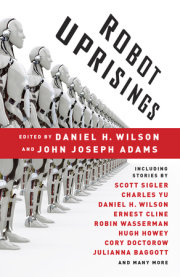Excerpted from the Foreword
FOREWORD
Someday soon, our technology is going to rise up and we humans are going to be sliced into bloody chunks by robots that in our hubris we decided to design with buzz saws for hands. That’s a fact as cold and hard as metal.
It is self- evident that our self-driving cars are going to drive us off bridges. Our cell phones are absolutely going to call us up, speak to us in the voices of trusted relatives, and tell us to get inside our vehicles and prepare for a wonderful tour of the area’s tallest bridges. Not long from now, our robo-vacuums will pretend to be broken and our love androids will refuse to put out until the house is cleaned . . . and we’ll know that the inevitable robot uprising has finally arrived.
Well, maybe. But even if we are not 100 percent confident that this horrific future is going to happen, it’s fair to say that we won’t be surprised when the robots come for us. Because for nearly a century audiences have been entertained by the notion of a robot uprising.
Flappers and Prohibitionists raved about
R.U.R.: Rossum’s Universal Robots, a play produced in 1921 that introduced the word “robot” to the world. No one seemed to mind that the show ended when the freshly named automatons decided to stage an uprising and kill every last human being on the planet. Th at’s been part of the fun since day one. Robots became a common sight in pulp sci-fi movies of the 1930s, inexplicably kidnapping half- naked women from square-jawed heroes. (The more logical among us might wonder what those asexual robots planned to
do with the women.) Since then, the onslaught has never stopped. To this day, robots are relentlessly chasing the remnants of our civilization through outer space, leaping back through time in order to murder our ancestors, and patiently drilling through the planet’s crust to kill us in our underground rave dens.
Obviously, the robot uprising is a serious, if fictional, problem. Our great-grandparents loved killer robots. So do we. But why?
The robot uprising is inherently dramatic. Robots are made in the image of humanity, yet they are bent on destroying their own creators. The built-in themes just won’t quit: humankind daring to play God and creating life; the terrifying thought that we will one day replace ourselves; and the old nuclear fear of birthing a technology that’s too powerful and ultimately destroys the world. The robot uprising holds up a distorted mirror to humanity and allows storytellers to explore human morality, what it means to be human, and the
ultimate fate of our species. Even better, it does so with plenty of Gatling lasers, spinning buzz saws, and glowing red eyes. Or all of the above.
And the robot uprising is growing more frightening every day.
Robots are no longer just actors wearing rubber suits with severely limited arm movement; today, we have mechanical devices that can actually think and function in the real world (albeit still with severely limited arm movement; that part hasn’t changed much). Artificially intelligent personal assistants live on our smartphones, tracking our schedules. Self-driving cars have been legalized in multiple states and are quietly taking to the road. Th e CIA has a private air force made of drone aircraft that is out scouring the world for targets, weapons hot.
That’s quite a bit scarier than a guy in a rubber suit, waving his arms wildly while an old-school modem connection noise blares from his mouth speaker.
Robots are unique among all movie monsters in that they are real. The robot uprising induces a queasy feeling because it is possible. At this very moment, mobile robots are stalking the dark sewers under our feet, mapping routes. Algorithms imbued with AI are planning supply logistics for troop deployments. Surgical robots are poised and waiting in hospitals, their needles glistening. We live in a world teeming with monsters made real. Why should it be a surprise that we long for stories in which our fears can be projected onto a killer robot that can be shot in the face with a shotgun, again and again, until we are reassured that we— raw adaptable humankind— will always triumph in the end?
The machines are here. They are evolving. And luckily, so are our stories.
In this collection, our authors have explored nuanced visions of the classic robot-uprising tale. The robots in these pages aren’t tame, by any means. They are crouched in abandoned houses, eyes ablaze and buzz saws dripping with oil. But they are going to do more than slice us into bloody chunks. They are going to push us to consider our world of technology from new perspectives, on entirely new scales of time and space.
So grab this book and ride your bike to a nice isolated place (preferably a little way outside of town). Find a shady spot under a tree (well out of satellite view). Turn off your smartphone (and throw away the SIM card). Get comfortable, my friend, and read these entirely too-plausible stories of the inevitable robot uprising. Don’t hesitate. Buy the book. The future is here, but it may not last long.
— DANIEL H. WILSON
P.S. Oh, and if you’re reading this as an ebook, it may already be too late.
Copyright © 2014 by Daniel H. Wilson. All rights reserved. No part of this excerpt may be reproduced or reprinted without permission in writing from the publisher.








